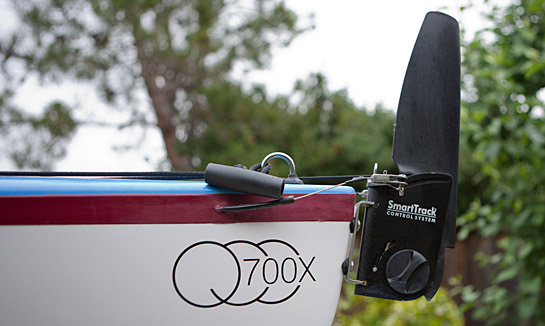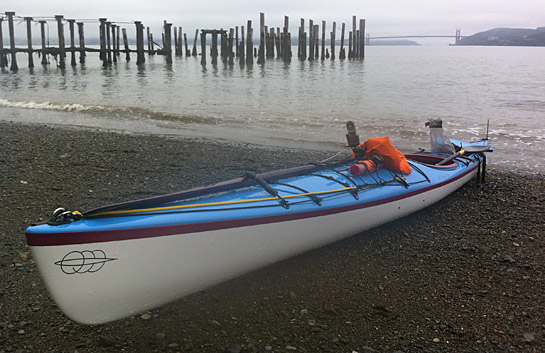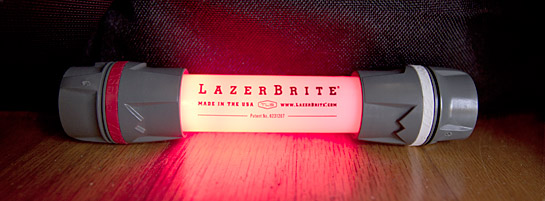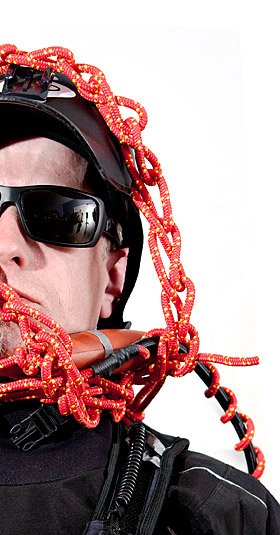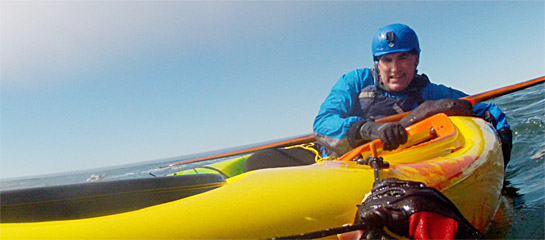
Just because you might get an assisted rescue doesn’t mean that you shouldn’t be able to be a comfortable, active participant in your own rescue!
No (hu)man is an island, so the saying goes, and so it goes with paddling: Solo kayaking is a pretty risky endeavor, so many paddlers go out in teams or groups. But even in a group, kayakers must learn to be reasonably self-sufficient in order to not just build trust and stay safe, but to have fun.
Self-sufficiency means being able to take care of yourself in the conditions you’re expecting. You’ll notice that this is all relative. This could mean knowing a paddle float re-entry or knowing 16 different kinds of rolls, depending on the kind of paddling you expect to do. Self-sufficiency breeds confidence in yourself and engenders trust in your fellow paddlers.
In the photo above, I am the one in need of rescue – that’s my hand and point of view from the water, as a swimmer. I ran a pourover and weighted my boat too far forward, landing nose first into a suckhole on the other side of the rock. (You do have perimeter deck lines on your kayak, right?) I blew several braces and rolls in active water in a rock garden (note to self, and readers: Sculling brace/roll probably would have worked great in that highly aerated water!), and I was assisted by two nearby friends. Had they not been there, though, I’d still have had a number of options. Swim with my boat tethered to me with a cowtail. Wrap my legs around my boat and swim with it to calmer waters. Wait until the hydraulics flushed me into an area with less surge and execute a cowboy scramble. Catch my breath and do a re-entry and roll. But, with two nearby paddling companions, we did a boring ol’ t-rescue. Because I knew I had other options, I was totally comfortable and not the least bit scared (and had the conditions been any bigger, I’d not have run that feature at all).
It’s All Relative
There is no one-size-fits-all Self Sufficient Kayaker merit badge. Self-sufficiency on a calm lake with no wind is different than self-sufficiency in coastal conditions with twelve-foot, 24-second swell and 30-knot winds. Both are equally valid, assuming your level of self-sufficiency is matched to the conditions that you find yourself in. (The subjective nature of risk is why I take care not to begrudge anyone their flat-water mellow paddles, nor dismiss stormy-weather paddling as reckless antics.)
I’d go so far as to argue that experience and judgement is more important than skill. Can’t execute a cowboy scramble rescue in active water? Then at least make sure you never get separated from your boat and paddle. Or, if help isn’t coming quickly, fall back to a paddle float rescue. When help does come, you can be an active participant in your recovery by following directions and communicating actively with your rescuer – heck, you can even tell your rescuer exactly what you want or need, if you choose to be recovered in a specific way. If you only know one or two rescue techniques, but you’ve practiced them enough to have them be second nature, then you’re probably better off than knowing a having been taught a dozen obscure rescue types that you never find the time practice. Remember, as stated in a previous article: You never rise to the occassion, you sink to the level of your training.
The key to all of this is effective self-assessment and risk assessment. This is a multi-faceted challenge: One must balance self-confidence with knowledge of one’s limits, fully consider worst-case scenarios without getting psyched out, and weigh the benefits of pushing your limits – which, of course, is how we all learn – while retaining a reasonable margin of safety. How this is done varies person to person, but the important thing is that it must happen. Risk blindness and overconfidence can put people’s lives in danger, not the least of which could be your own.
Self-Sufficiency and Group Paddling
But here’s the thing: If something really does go wrong and you’re paddling with a group, you’re not on your own, are you? Everyone will surely rally to help, right? That’s why we kayak in groups, after all. So how does self-sufficiency matter if most of us tend to paddle in mutually-supportive groups?
Imagine a scenario in which there are multiple capsizes in a short amount of time; this could be due to a sneaker wave, sudden winds, or a panicked swimmer. Alternatively, conditions could split up your group, creating individuals that are too far apart from each other to render assistance. These scenarios are all very real ones. The reality is that shit happens, and you may need to stabilize your situation before anyone can help you.
If you are self-sufficient and you’re not as bad off as others in the situation, executing your own recovery puts you back in the game and adds you to the resources your group has in an emergency. You can do whatever you are able, be it simply looking outside for more big waves or helping get people back in dry boats doing t-rescues. Either stabilize your own situation or that of someone else. Just don’t be a liability. (Heck, in BASK, we have an annual Rodeo in which a team-based “all-in” capsize scenario is a game, which is a great way to learn these lessons!)
Make Recoverable, Responsible Mistakes
We all need help from time to time, and no sensible kayaker can argue against that. Errors in judgement happen all the time; usually the cost of these errors is minor, but not always. The sea is a fickle mistress. Mistakes happen. However, it’s your responsibility to both assess the potential worst-case scenarios to any decision, and to reasonably be to able look after yourself and recover from casual mishaps for the given conditions you encounter. Learn from every mistake. Invest the time to post-mortem rescues, recoveries, and mishaps. Be open to well-intentioned critique without getting defensive. Over time you’ll make fewer mistakes, build trust with others, and most importantly, you will build trust with yourself.
Your fellow paddling partners are putting their trust in you: Don’t betray that trust. Otherwise you should hire a guide who is obligated to watch out for you regardless of your skill level.
Read More

